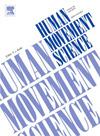Acute effects of voluntary breathing patterns on postural control during walking
IF 1.9
3区 心理学
Q4 NEUROSCIENCES
引用次数: 0
Abstract
Introduction
Breathing and postural control is reported to be both neuromuscularly and mechanically interdependent. To date, the effects of voluntary abdominal and thoracic breathing (VAB and VTB) on the EMG activity of muscles involved in both respiratory and postural functions, as well as gait biomechanics related to these breathing patterns, have not been investigated in young, healthy adults. The aim of the study was to evaluate the EMG responses of neck and trunk muscles, as well as the kinematic, stability, and kinetic parameters of gait induced by VAB and VTB compared to involuntary breathing (INB).
Methods
Twenty-four healthy, physically active participants (12 men and 12 females) were required to complete three two-minute walking sessions on an instrumented treadmill (e.g. devices with capacitive sensors embedded beneath the running belt) at 5.0 km h−1, first with INB and then alternatively with VAB and VTB. A respiratory inductive plethysmography unit was used to provide real-time visual feedback of the breathing pattern performed by each participant. The EMG activity of the sternocleidomastoid (SCM), upper trapezius (UT), thoracic and lumbar erector spinae (TES and LES), as well as spatiotemporal (step width, stride length, stride time, stance phase, swing phase, and cadence), stability (anteroposterior and mediolateral center of pressure trajectory), and dynamic gait parameters (vertical ground reaction forces, vGRF) were recorded during each testing condition.
Results
Our findings revealed that both voluntary breathing patterns significantly affected the EMG activity of the SCM (p < 0.01) and UT (p < 0.05), with the activity between these muscles, as expressed by the SCM:UT ratio, being more balanced during VAB (0.94) and VTB (1.05) compared to INB (0.73). Additionally, VAB walking led to a narrower step width (p < 0.01) and reduced vGRF over the forefoot (p < 0.01) compared to INB walking. Neither VAB nor VTB influenced the activation levels of the LES and TES, nor did they affect other spatiotemporal, stability, or dynamic gait parameters (p > 0.05).
Conclusions
Our findings suggest that certain gait parameters (e.g. step width, forefoot vGRFs) are primarily influenced by VAB compared to INB, likely due to the more balanced activation of the SCM and UT muscles. This balanced activation may enhance head stability and control during walking, thereby contributing to improved postural control.
行走时自主呼吸模式对姿势控制的急性影响。
简介:据报道,呼吸和姿势控制是神经肌肉和机械相互依赖的。迄今为止,尚未在年轻健康成人中研究自主腹胸呼吸(VAB和VTB)对参与呼吸和姿势功能的肌肉肌电图活动的影响,以及与这些呼吸模式相关的步态生物力学。本研究的目的是评估颈部和躯干肌肉的肌电反应,以及与不自主呼吸(INB)相比,VAB和VTB诱导的步态的运动学、稳定性和动力学参数。方法:24名身体健康、身体活跃的参与者(12名男性和12名女性)被要求在跑步机上以5.0 km h-1的速度(例如,在跑步带下面嵌入电容式传感器的装置)完成3次两分钟的步行,首先使用INB,然后交替使用VAB和VTB。使用呼吸感应容积描记仪提供每个参与者呼吸模式的实时视觉反馈。记录各测试工况下胸锁乳突肌(SCM)、上斜方肌(UT)、胸腰椎竖脊肌(TES和LES)的肌电活动,以及时空(步宽、步幅、步幅时间、站立相位、摆动相位、节奏)、稳定性(前后、中外侧压力中心轨迹)和动态步态参数(垂直地反力,vGRF)。结果:我们的研究结果显示,两种自主呼吸方式均显著影响SCM的肌电图活动(p < 0.05)。结论:我们的研究结果表明,与INB相比,VAB主要影响某些步态参数(例如步宽,前足vgrf),可能是由于SCM和UT肌肉的激活更为平衡。这种平衡的激活可以增强行走时头部的稳定性和控制力,从而有助于改善姿势控制。
本文章由计算机程序翻译,如有差异,请以英文原文为准。
求助全文
约1分钟内获得全文
求助全文
来源期刊

Human Movement Science
医学-神经科学
CiteScore
3.80
自引率
4.80%
发文量
89
审稿时长
42 days
期刊介绍:
Human Movement Science provides a medium for publishing disciplinary and multidisciplinary studies on human movement. It brings together psychological, biomechanical and neurophysiological research on the control, organization and learning of human movement, including the perceptual support of movement. The overarching goal of the journal is to publish articles that help advance theoretical understanding of the control and organization of human movement, as well as changes therein as a function of development, learning and rehabilitation. The nature of the research reported may vary from fundamental theoretical or empirical studies to more applied studies in the fields of, for example, sport, dance and rehabilitation with the proviso that all studies have a distinct theoretical bearing. Also, reviews and meta-studies advancing the understanding of human movement are welcome.
These aims and scope imply that purely descriptive studies are not acceptable, while methodological articles are only acceptable if the methodology in question opens up new vistas in understanding the control and organization of human movement. The same holds for articles on exercise physiology, which in general are not supported, unless they speak to the control and organization of human movement. In general, it is required that the theoretical message of articles published in Human Movement Science is, to a certain extent, innovative and not dismissible as just "more of the same."
 求助内容:
求助内容: 应助结果提醒方式:
应助结果提醒方式:


